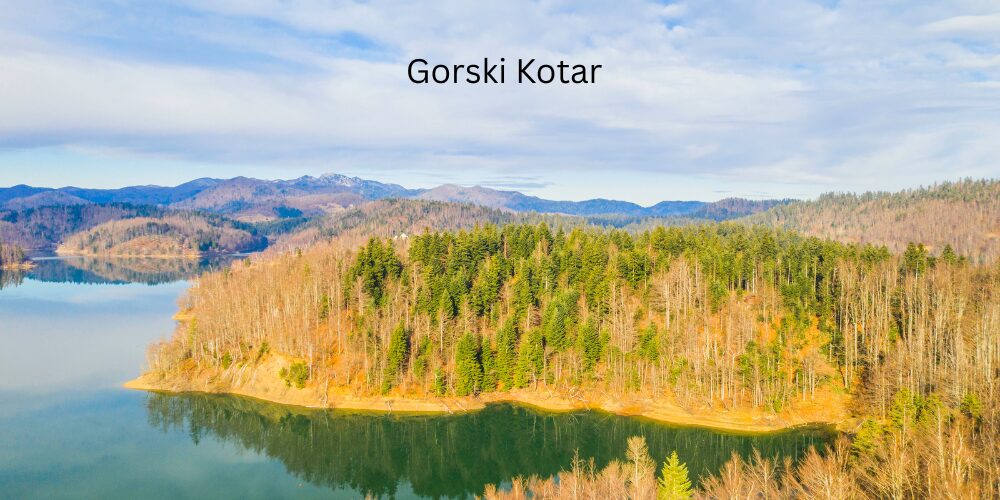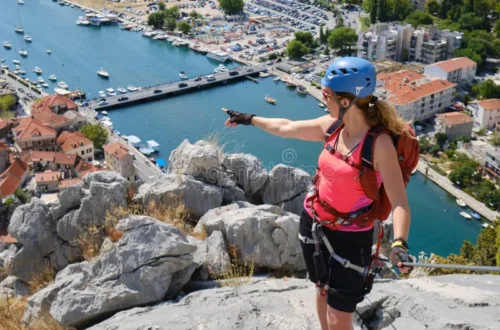Via Ferrata Bijele Stijene: Croatia’s Wild Alpine Playground
Hidden deep in the heart of Gorski Kotar, lies one of Croatia’s best and wild climbing destinations: Bijele Stijene, or “White Rocks.” This unique limestone labyrinth, part of the Velika Kapela mountain range, offers one of the country’s toughest and visually stunning via ferrata experiences. Known for its untamed terrain, alpine ambiance, and surreal rock formations, the Via Ferrata Bijele Stijene is a must-do for serious adventurers and lovers of remote wilderness.
Croatia is better known for seaside escapes and historic cities but Bijele Stijene offers a taste of the country’s wild, mountainous interior. It has an atmosphere that feels more like the Austrian Alps than the Dalmatian coast. Here’s everything you need to know about tackling this unforgettable route.

What and Where Is Bijele Stijene?
Bijele Stijene, meaning “White Rocks,” refers to a karst rock formation in the heart of Gorski Kotar, a mountainous region often called “the green lungs of Croatia.” The area lies within the Velika Kapela range, at altitudes reaching over 1,300 meters, and forms part of a strict nature reserve.
The landscape here is a dramatic showcase of nature’s power: jagged limestone towers, deep crevices, spires, and narrow passages, all sculpted by centuries of erosion. It’s one of the most unusual and impressive rock formations in Croatia, and navigating through it feels like entering a prehistoric world.
The Via Ferrata Bijele Stijene goes through this rugged terrain, combining fixed steel cables, ladders, and iron steps with traditional hiking and scrambling. It’s not a long route, but it’s technically demanding and physically intense, suitable for experienced adventurers or guided groups.
Click here for info about another fantastic Via Ferrata in Croatia.
Highlights of the Route
- Real alpine climbing atmosphere
- Deep forests and isolated wilderness
- Spectacular karst formations and panoramic views
- Chance to spot wildlife like eagles, lynx, and chamois
- Backcountry experience with basic mountain shelters
Difficulty and Terrain
- Grade: Moderate to Difficult
- Duration: 3–5 hours (via ferrata loop + approach and return)
- Elevation: ~1,300 meters
- Gear Required: Helmet, harness, via ferrata lanyard, gloves, sturdy hiking or approach shoes
This route is not suitable for beginners or people afraid of heights. The vertical sections are protected with cables and iron fixtures but there are exposed ridges, narrow passages, and some areas requiring confident movement on steep rock. Good physical condition and sure-footedness are essential. Winter ascents require full alpine gear, including crampons and ice axes.
Click here to read about a selection of European adventures.
The Experience: Step-by-Step Through the White Rocks
1. The Approach: Into the Forest
The adventure begins with a hike from the Klanac or Jasenak trailheads. It winds through dense beech and fir forests that cloak the lower slopes of Velika Kapela. The air is cool and fresh even in summer, and the path gradually climbs to the Bijele Stijene Nature Reserve.
As you gain elevation, the forest gives way to rocky clearings and meadows, with wildflowers blooming in spring and early summer. Red-and-white trail markers lead you to the start of the via ferrata section at the edge of the White Rocks.
2. Climbing Through Stone Cathedrals
The first section of the via ferrata takes you to the surreal rock formations of Bijele Stijene. Towering white limestone spires surround you. The trail begins weaving up and through steep passages, with fixed steel cables and iron rungs assisting your ascent.
This part of the route feels almost like a natural maze — you’ll duck under overhangs, climb narrow chimneys, and squeeze through vertical corridors worn smooth by centuries of weather and, more recently, adventurers’ boots.

The Heart of the Via Ferrata: Exposed Ridges and Aerial Traverses
After an initial climb, the trail opens up to airy ridges and breathtaking views over the surrounding mountains and deep valleys. These are the most dramatic parts of the route, where the exposure becomes significant — but the scenery is utterly spectacular.
You’ll cross narrow bridges of rock, with only a steel cable between you and a 50-meter drop. But if you’re confident in your footing and safety gear, this is where the route truly shines. The mix of physical challenge and natural wonder is exhilarating.
Summit and Panorama
The route culminates near the highest points of the Bijele Stijene massif, around 1,335 meters above sea level. From here, you’re rewarded with a sweeping panorama of Gorski Kotar, the nearby Samarske Stijene, and, on a clear day, even distant glimpses of the Adriatic coast.
This is a perfect spot for a break — have a snack, snap some photos, and just soak in the peace and silence of the highlands.
You need to be in good condition for Via Ferratas. Click here to turbocharge you health and fitness.
Descent and Return
The descent can be made by looping around through easier hiking paths or retracing parts of the via ferrata with caution. There are marked trails back to your starting point, and nearby shelters like Planinarski Dom Bijele Stijene (a mountain hut) offer a place to rest or even spend the night.
When to Go
- Best Season: Late spring to early autumn (May–October)
- Avoid in winter unless fully equipped for snow and ice
- Midweek visits recommended to avoid crowds (though this area is never tourist-heavy)
If you want a selection of stylish, practical and outdoors appropriate menswear, click here.
What to Bring
- Full via ferrata gear: helmet, harness, via ferrata lanyard, gloves
- Water and food: there are no shops or cafes nearby
- GPS or detailed trail map: cell service is limited in the mountains
- Layers: even in summer, the weather can change rapidly at higher elevations
- First aid kit and headlamp, especially if you’re doing a longer hike in/out
If you want to lose weight before attempting Via Ferratas , click here.
Nearby Adventures
If you’re already in the area, you might also consider visiting:
- Samarske Stijene: A neighboring formation with even wilder terrain
- Risnjak National Park: One of Croatia’s premier hiking destinations
- Zeleni Vir and Vražji Prolaz: A dramatic gorge and waterfall near Skrad
- Platak and Snježnik: Great for panoramic ridge hikes
Final Thoughts: Why Bijele Stijene Is Special
Via Ferrata Bijele Stijene isn’t just about the climb. It’s about the wildness, silence, and solitude of one of Croatia’s most untouched landscapes. It offers the kind of adventure that rewards those who stray from the beaten path — challenging, beautiful, and humbling.
Whether you’re an experienced via ferrata enthusiast or a seasoned mountain hiker looking for something different, Bijele Stijene will leave a lasting impression. It’s a reminder that Croatia’s magic extends far beyond the coast — to the rocky highlands, where white stone cathedrals pierce the sky and nature still rules.

